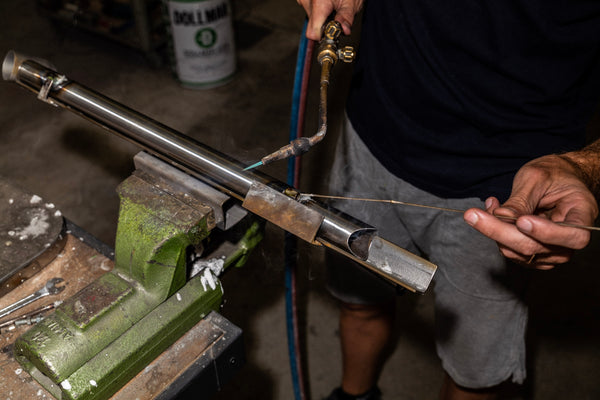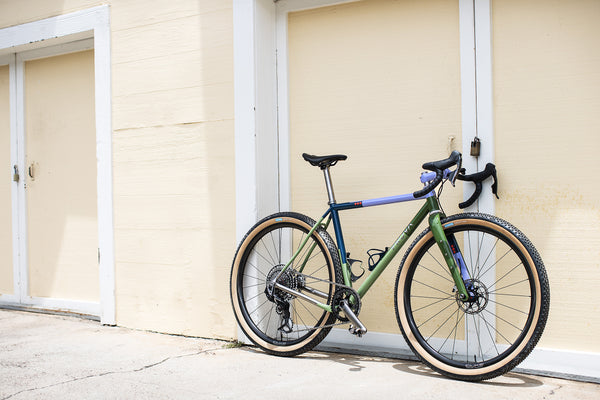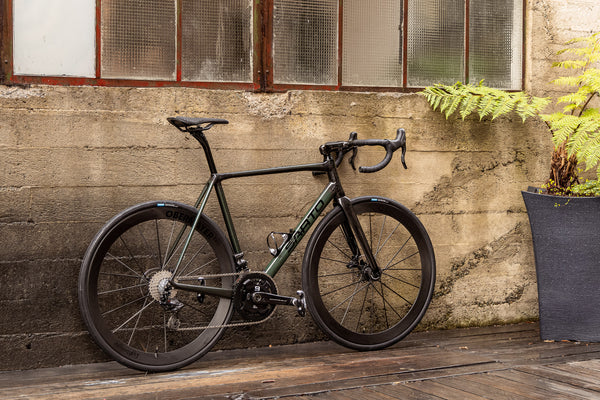The disruption of the past few years cut far and wide. But for Australian bike wheel manufacturers Partington, when the global shutdown put the brakes on momentum, they took the opportunity to reimagine their MK1 R-Series wheels with a more sustainable mindset, accelerating their roadmap to execute a new design while simultaneously reimagining the origin of their externally-produced parts, bringing everything either in-house or produced within 60 miles of their Australian HQ.
We recently sat down between screens with Partington founder and namesake Jon Partington to discuss product and process iteration, carbon fibre tech, performance and whether comfort can be quantified.
Pete: Hey, Jon.
Jon: Hey, Pete. How are you?
Pete: Good, thanks, mate. How are you doing?
Jon: Yeah, good, thank you.
Pete: With the new MKII Partingon's out, my first question is whether Mark II of the R-Series is a natural iteration of Mark I?
Jon: The answer to that is quite simple. For Mark I, we still had some external partners making critical components. Then came the supply chain disruption during COVID, which for so many reasons, made clear the need for us to start a sovereign supply capability or, even better, manufacture everything in-house.
Most notably, we needed to find an alternative solution for our hubs. We always had a Partington hub as part of our technology roadmap, but the disruptions I mentioned forced us to expedite it to fill a gap. The change was somewhat forced upon us, but in retrospect, it has been a blessing in disguise. It allowed us the opportunity to exercise some design thinking we had around the hubs, notably around the bearing arrangements. We wanted to ensure that what we came back with was a superior version of what we left behind. And my thinking is that when you make a significant design change, it's a new product. You can't pretend it's the same product when there are some fundamental differences.

Pete: Knowing when an iteration becomes a new version is a little fuzzy.
Jon: Yeah, that's true. A significant technology step rather than a subtle change would be one way of putting it. We thought, "Well, if we're looking at making some fairly wholesale changes around the hub, then let's optimize elsewhere, given we've now got the opportunity to execute on what we know." As a young company, you go into projects with a lot of ideas and a lot of enthusiasm and motivation, which is essential for getting stuff off the ground. But there are things you don't know, and there's inevitable learning along the way.
Specifically, in the execution and delivery of Mark I, there were plenty of things in retrospect that we thought could be done better, be that process equipment, subtle changes in the design, be it in the carbon fibre layer, the geometry of some parts, the way we prepare some parts. That sounds like a lot, but it's just the natural process of making anything. You create, you learn, you make better.
Pete: I imagine the explosion of rider feedback once the wheels hit the ground only added to the circle of development.
Jon: From a customer-facing perspective, just having people on the wheels in different environments was a great opportunity to get feedback - people on different bikes, terrain, tires, group sets, and riding styles. That's a lot of variation right there! So we got some valuable feedback over the months. But then the other feedback loop was internal in manufacture. When we first launched Mark I, there were two people in the company, three at a maximum, when we started shipping products. And as the company's grown - we're about 20 heads now - we bought on more and more manufacturing operators, all of which required that we elevate processes and evolve equipment and machinery.

Pete: What are some of the things you're particularly proud of on MK II?
Jon: There are a few little bits. Certainly, the hub has been a real success. We achieved a hub arrangement that rolls radically better than anything else we can currently find on the market. There's a lightness to the freehub engagement and disengagement. It's got a fairly unique aesthetic, but it's still true to our style, and the branding is subtle. As an extension, we've done some further work on improving the performance of the bonded joint between the spoke and the hub, which encompassed developing our own resin system to do that bonding.
Pete: What led you to develop your own resin this time around?
Jon: A few reasons. The way we bond things is proprietary to us, and we need some particular characteristics in the resin to enable us to bond and get a high-quality aesthetic without rework or cleaning. We also wanted to improve the bond strength between the aluminium hub components and the spoke and increase its toughness and thermal tolerance. And then the third part was all about surface preparation and creating consistent, repeatable bonded joints. For that, we collaborated with Deakin University, and, obviously, they've got a lot of capability in the sort of chemistry space and access to a lot of specialist equipment that we ordinarily wouldn't have access to. Ultimately, we developed a resin system with a bond strength four times stronger than we had previously.

Pete: Way to overachieve.
Jon: Haha, yeah. Plus, it has a much higher temperature tolerance. We've now got a better understanding of the surface treatment requirements and are able to achieve a high-quality bond aesthetic that it's sometimes tough even for me to visually determine whether it's bonded!
Pete: Is it analogous to glue, where you might see a little bleeding out under compression?
Jon: Exactly. But in our case, we don't want to see any adhesive extrusion.
Pete: I imagine quality control and associated processes got a significant boost, given you now have greater control of more of the materials.
Jon: Absolutely. We introduced a further layer of quality control, which is only possible because everything's now made in Australia or within a 100K radius of our factory. Now, we have total process traceability from when we start using raw materials. Plus, as an additional layer of security, we developed a testing process to ensure the rigorous consistency of bonded components. That one sentence has a whole world of work and some exciting thinking. But it's one of the things of which we're most proud.
Pete: Any other notable changes?
Jon: Yep, we increased spoke tension and a few other things in our final assembly. And the last thing is we revised the lay-up for the rim, which saved us a bit more weight and increased rider comfort. To speak to that, we allowed some radial flex in the design whilst maintaining high lateral stiffness and did all that with a weight saving as a nice bonus.

Pete: Why did you decide to go after that characteristic, and is it correct to assume that more comfort is always good, or can that come at the cost of performance?
Jon: I got asked a similar question recently. Someone was talking about performance and how well it rolled and asked what benchmark we used to develop that against. My response was that in some instances we aim for the maximum or the minimum. We want minimum friction and minimum rolling resistance. You want maximum comfort, and there's never an instance where you'd like more friction or less comfort. That's in contrast to lateral stiffness, where people generally want stiff wheels but not without limits because you start compromising other attributes. So there are attributes that we do benchmark, like weight, stiffness, rim geometries, internal rim widths and aerodynamic profiles and even aesthetics. But for attributes like comfort or minimizing friction and rolling resistance, we just shoot for the stars, and we just make it as good as possible based on the technology we have available at the time.
Pete: I presume improved comfort is only noticeable through experienced feel. You go for a ride, you know your bike, your wheels, you don't change much, you keep the same tires.
Jon: Yeah, and it is subtle, especially if you think the movement in the wheel is significantly less than that of a tyre. But it is tangible. Even though we didn't go after a metric or try to quantify our improvement, we were considerate of it in the design phase, and then we had it verified by the unprovoked feedback from test riders and customers.
Pete: Don't mention comfort - don't think about elephants!
Jon: Exactly that, haha. We're conscious of giving people free rein and not influencing their feedback. So we were pleased when everyone, unsolicited, told us Mark II was more comfortable.
Pete: In practice, how did you achieve greater comfort?
Jon: With composites, you've got a certain freedom regarding designing in directional behaviour of the materials. You can execute design thinking or a design idea by strategically placing the materials, which was the extent of deliberate efforts to increase comfort. In our case, we aimed for a slight ovalizing of the wheel.
Pete: You mean the wheel changes shape ever so slightly under load?
Jon: Yeah, but it's more nuanced than just going from round to oval. A tire is fundamentally round, but at the contact patch, it flattens. That's the bit you're interested in, that sort of low radial deformation, and it's subtle, but it's the only attributable thing to the improvement in comfort.

Pete: With the launch of MKII, you're offering the original mid-depth 39/44 flavor, but word is there's a shallower version coming later in the year. Why did you decide to make two rim depth options this time around?
Jon: It's fulfilling our original intent but also in response to customer demand. The family of products is known as the R-Series suite of wheels. In Mark I and currently in Mark II, we have a 39-millimetre front with a 44-millimetre rear. And as you mentioned, we're also close to launching a shallower wheelset. The motivation is that a rim with reduced depth is more suited to adverse weather conditions, less sensitive to wind, lighter, and better against the clock on the climbs. Between the two rim variants, we hope to cover all of a rider's needs, bar radical aero depths, which we're also looking at.
Pete: Jumping from the tech to the Partington community momentarily, when we spoke about MK I, you mentioned how hardcore and passionate Partington users were. Do you have any new stories from the road? Any "Bloody hell, our wheels did that??" moments.
Jon: All the time! People often say, "Look, the wheels are great out of the box, beautiful and the rest. But then I've just set all these new PBs on my Strava, and I've got all these new segment times and stuff."
Pete: Nice.
Jon: We had a guy, Alex Richardson. He was a pro in the UK, and he's semi-pro now with a normal job, but he raced the National Championships in Great Britain and came third to Mark Cavendish. Alex bought a pair of our Mark II’s this year and was so convinced they gave him an edge that he immediately purchased another two sets for this year.
Pete: A swift success! And before I make any more bad jokes, let me finish by saying thanks for your time today, Jon.
Jon: You too, Pete. Cheers!










Back to Journal